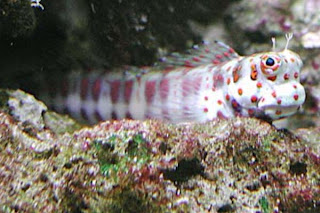Some blennies are among the best make-believe artists in the fish world. They look like another —harmless— species, but this is just a trick to get close enough to other fish to bite a chunk out of them.
In the struggle to eat and avoid being eaten, fish (including blennies) have evolved a vast range of survival techniques. One is the art of mimicry— that is, pretending to be something that you are not. The sabre-toothed blenny, for example, looks almost identical to the cleaner wrasse. The cleaner wrasse is
a harmless little fish that picks off parasites from other fish, relieving them of the irritation caused by the creatures. By looking like a cleaner wrasse, the blenny is able to get close to other fish. It can then bite a chunk of fin or skin from the unsuspecting victim, getting a meal for itself. Versatile Survivors
Other blennies look like venomous species, and so they are avoided by predators. For example, the harmless Red Sea mimic blenny looks like the poisonous black-line fang blenny. Many blennies are also masters of camouflage, and blend in with the seaweeds and other growths found in the pools that these fish inhabit. This camouflage is so effective that it is easy to miss large specimens, even at close quarters. Yet another survival technique is found among some species that live in shallow rock pools that heat up or become low in oxygen. At such times, the blennies leave these pools and hop overland to the nearest large pool where the water is cooler and has more oxygen. Such species, not surprisingly, are called rockskippers.








0 comments:
Post a Comment